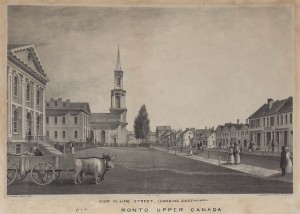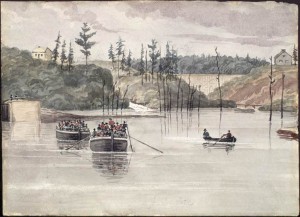Society in the 19th Century
|
Economy: |
Society: | Politics: |
| -Fishing
-Forestry -Shipbuilding -Clearing land to farm and build houses -Barter economy -Tenant farmers -Fur trade (rural settings) -farmers mortgaged their crops -trade with Britain and US -farming wasn’t always successful -absentee landlord(land speculators) -clergy reserves and government reserves tied up the lands |
-less interaction because of distance between neighbours.
-closer knit community -family background is important -church is part of their routine -quiet environment -church is a part of their routine (meet with neighbours) -religious holidays are when communities come together (music) -clear class structure -class boundaries are more obscured in Canada vs Britain -lower class want democracy |
-lower class want democracy
-upper class is in power -loyalty towards Britain -tenant farmers |
Farming

Pioneer homestead, Chatham, Upper Canada 1828 P.J. Bainbrigge
This image shows crops, simple log home from the cut trees in the back ground, and a farmer talking to who is presumed to be his land lord.
This is definitely a farm, that has crops, and it shows the presumed long distance between houses because he doesn’t look to have neighbours close by. The top hat on one of the persons of this image shows that he is an upper class person
Social Class

North side of King, East of Toronto Street, 1829 (James Pattinson Cockburn)
Image shows 3 men in in coats and top hats and a kid in the same attire, a jail, a court house and a church, also lots of buildings on the right side with large amounts of people walking on the streets.
Looking at the men on the picture it looks like they are wearing formal and expensive clothing, the jail and courthouse and church shows that they live in a major city, and the large amounts of buildings tells us that lots of people visit or live in this city. By these characteristics it is safe to assume that this is an upper class city.
Religion

King St. E., looking e. from Toronto St., Young, Thomas, Year/Format: 1835, Picture
This is the same street and view like in the last picture but you can see some cows and citizens.
The large church can tell us that lots of people must go to church in this area.
Land Issues

This paper shows reserved or bought land.
Upper class bought land they could farm or build homes on. The government and churches got lots of reserved land to work with too.
Loyalty to Britain

Crown and Clergy Reserves, Newtown, Upper Canada, with one-seventh of the land held for clergy reserves, and oneseventh to produce government revenue, c. 1800. National Archives of Canada, NMC288
Jones Falls, Rideau Canal, Upper Canada. Artist: Bainbrigge, Philip John, 1817-1881. ca. 1838
Picture shows large boats with lots of people in it who are sporting red coats and oddly shaped hats. (Also not relevant to the topic, I think there’s a dam in the back ground.)
The people in the boats are loyalists, they were also called “red coats” at the time, I they were the soldiers who were loyal to Britain.